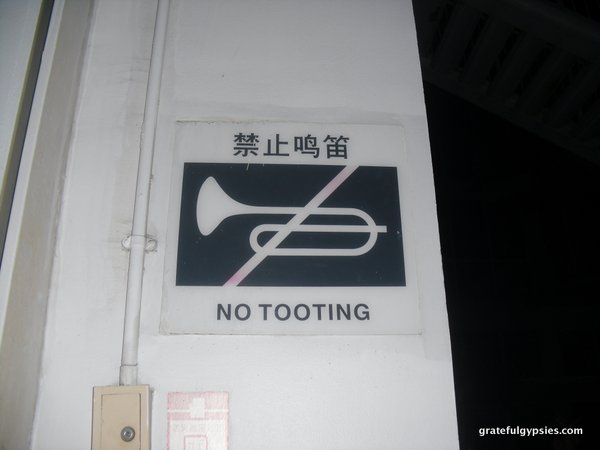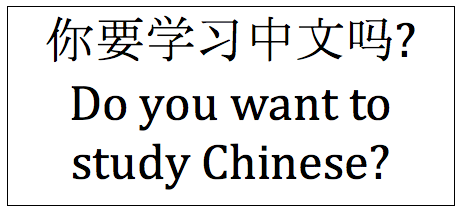Yes No Questions in Chinese Posted by sasha on Apr 27, 2016 in Uncategorized
We’ve already talked about asking questions in Chinese here on the blog, so go back and review that post if you need more practice with your who/what/where/when/why type of questions. For this post, I’d like to review asking and answering simple yes/no questions in Chinese. There are basically two ways to ask these types of questions, so let’s take a closer look at both. First of all, though, let’s talk about yes and no in Chinese.
There is No “Yes” or “No”

How can there be “no tooting” without a word for “no”?!
Yes/no questions in Chinese may seem impossible when you realize that there really aren’t Chinese words that directly translate as “yes” or “no.” Never fear, though – we’ll get to the questions in due time, and they are in fact possible. In Chinese, the words you will use to express the meaning of “yes” or “no” depend entirely on the context/grammar of the question. You’ll see how this all works through the examples that follow. Now let’s get on with the lesson and learn about the two ways to ask/answer these types of questions.
Using the Particle “Ma” (吗)

The easiest way to form a question in Chinese – yes/no questions to be more specific – is to simply attach the particle ma (吗) to the end of a statement. Here are a few examples of statements and how they become yes/no questions with the addition of 吗:
1. You are a student.
你是学生.
nǐ shì xué shēng
Are you a student?
你是学生吗?
nǐ shì xué shēng ma
2. He has children.
他有孩子.
tā yǒu hái zi
Does he have children?
他有孩子吗?
tā yǒu hái zi ma
3. They want to go to Beijing.
他们要去北京.
tā men yào qù běi jīng
Do they want to go to Beijing?
他们要去北京吗?
tā men yào qù běi jīng ma
See how easy that is?! Just simply tacking 吗 onto the end of a statement changes it into a yes/no question.
Answers

Of course they want to go to Beijing!
Now, how do you go about answering these questions if there’s no Chinese word for “yes” or “no”? To answer affirmatively, you simply repeat the verb:
1. Yes (am).
是
shì
2. Yes (has).
有
yǒu
3. Yes (want)
要
yào
In these examples, the verbs 是 (to be), 有 (to have), and 要 (to want) are simply repeated to give an affirmative answer. How about negative answers? To give a negative answer, simply add either 不 (bù) or 没 (méi) in front of the verb:
1. No (am not)
不是
bù shì
2. No (doesn’t have)
没有
méi yǒu
3. No (don’t want)
不要
bù yào
Knowing whether to use 不 or 没 takes a bit of practice, but for now just know that 不 is much more common in forming negative answers. Now let’s look at the other way to form yes/no questions.
Positive/Negative

Another way you can ask a yes/no question in Chinese is to use both the positive and negative forms of the verb. If that seems strange, keep in mind that we do this in English as well – “Do you or don’t you want to go?” Thankfully, forming these kinds of questions is simpler and less awkward in Chinese. Let’s look at the same questions from above but change them to match this format:
1. Are you (or aren’t you) a student?
你是不是学生?
nǐ shì bú shì xué shēng
2. Does he (or doesn’t he) have children?
他有没有孩子?
tā yǒu méi yǒu hái zi
3. Do they (or don’t they) want to go to Beijing?
他们要不要去北京?
tā men yào bú yào qù běi jīng
See how easy that is? You can use either way you like to ask yes/no questions in Chinese, although it’s more common and a bit easier to stick with 吗. If you’re wondering why the tone of 不 changed from 4th to 2nd, go back and review our post about Tricky Tones.
Practice
Now that you’ve learned how easy it is to form yes/no questions, why not try a bit of practice? Try to translate these English questions into Chinese, using both forms taught in this post:
1. Can you speak Chinese?
2. Does she want to drink coffee?
3. Do you have a car?
4. Is this yours?
5. Are they American?

Build vocabulary, practice pronunciation, and more with Transparent Language Online. Available anytime, anywhere, on any device.
About the Author: sasha
Sasha is an English teacher, writer, photographer, and videographer from the great state of Michigan. Upon graduating from Michigan State University, he moved to China and spent 5+ years living, working, studying, and traveling there. He also studied Indonesian Language & Culture in Bali for a year. He and his wife run the travel blog Grateful Gypsies, and they're currently trying the digital nomad lifestyle across Latin America.




Leave a comment: